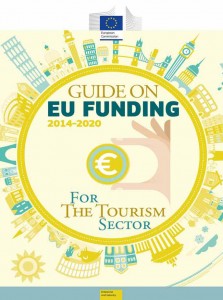In a recent guide compiled for the EU’s Committee of the Regions, the various funding opportunities for tourism available to local and regional authorities in the new programming period 2014-2020 were collated and outlined. As the third largest EU economic sector, tourism has a wide-ranging impact on economic growth, employment and social development.
A specific guide was also necessary because of the diversity of the tourism sector’s needs and the range of EU thematic programmes that can support it. Gathering and digesting information about many programmes is becoming easier, but remains a challenge for overstretched public entities promoting tourism destinations or developing tourism services. With the adoption of the EU Multi-Annual Financial Framework (MFF) for 2014-2020, new programmes are phased in while old programmes are phased out. The new MFF brings simplification at various levels: merger of EU funding programmes for easier access to information, harmonisation of application procedures, etc.
The European Structural and Investment Funds (ESIF) are the key funds that underwrite all programmes at EU level. Several programmes,including those related to territorial co-operation, are still in preparation and will be discussed in a later article in Council Journal in 2015. According to the Common Provisions Regulation, the full process of submission by member states and approval by the European Commission (EC) will be completed in early 2015. Operational programmes should define the measures that will be eligible for funding, in line with fund-specific investment priorities and thematic objectives addressing the Europe 2020 strategy. Within each member state, national and regional authorities will be directly involved in handling the ESIF and are thus expected to be familiar with the provisions made in the respective operational programmes.
This research carried out by the report was intended to add value to country-specific knowledge by sharing the thematic overview of available funding sources for tourism with other relevant stakeholders at the territorial level, and by describing complementary opportunities within territorial co-operation, other ESIF-related initiatives, and financial instruments.
The guide only covers what is indispensable to know for getting support. Some of the crucial steps for this are outlined below:
Step 1: Identify relevant programmes and financial instruments
To find out the most relevant programmes for your organisation go to www.council.ie/tourismfunding-table and consult the summary table there and whether it is applicable. This table indicates who can apply for what. Consult the information below to determining if it is worth further investigating opportunities offered by these programmes.
Step 2: Identify relevant calls for proposals / tender / applications
Start by checking the ERDF Programmes available in your region and verify that your project meets the selection criteria and investment priorities. Follow the application procedures of the relevant managing authority (some have an ongoing procedure, others accept applications at certain times.)
Step 3: Get familiar with the call specific documentation and forms (online)
Each call comes with a complete information package, usually including a ‘Guide’ with advice on preparation and submission. If something about the call is not clear, use the dedicated interface (functional mailbox, online page …). Help and advice for small firms/organisations in EU matters, including accessing markets both within the EU and beyond and applying for funding. The Enterprise Europe Network offers personal support to small EU firms on applying for funding, through a network of local contact points (see Enterprise Europe Network branch).
Step 4: Find partners where useful or required
Some (sub)programmes support cross-border or trans-European projects. You then need to have partners based in a number of other Member States and form a consortium. Many programmes websites offer a “looking for partners” service. Alternatively the page advertising a specific call often contains a section where potential partners can post their offer or request. See also the “Enterprise Europe Network” and its “Tourism and Cultural Heritage Sector Group”. The European Small Business portal also has a “business partners” section.
OUTLINE
The reformed structural funds, called the European Structural and Investment Funds (ESIF), are the key investment drivers at the EU level in general in the new programming period, support is given to thematic objectives, as opposed to sectors. There are 11 thematic objectives addressing Europe 2020 strategy for Smart, Sustainable and Inclusive Growth. These are:
1) Research & innovation;
2) Information and communication technologies;
3) Competitiveness of small and medium enterprises;
4) Shift towards a low-carbon economy;
5) Climate change adaptation & risk prevention and management;
6) Environmental protection & resource efficiency;
7) Sustainable transport & removing bottlenecks in key network infrastructures;
8) Employment & supporting labour mobility;
9) Social inclusion & combating poverty;
10) Education, skills & lifelong learning; and
11) Institutional capacity building & efficient public administrations.
These objectives are translated into fund-specific investment priorities. Tourism-related investments are explicitly mentioned under the European Maritime & Fisheries Fund (EMFF) and European Agricultural Fund for Rural Development (EAFRD) (tourist information, small-scale tourism infrastructure, co-operation for tourism services related to rural tourism), and the European Regional Development Fund (small-scale cultural and sustainable tourism infrastructure).
Nonetheless, tourism can be considered for support under any of the ESIF provided that related investments contribute to the priorities of the funds.
Funding strands available through the EU MFF 2014-2020 (notably those directly or indirectly related to the ESIF) as well as outside the EU budget were also considered for this report.
For each strand the following are provided: size and type of funds, to the extent that the information is publicly available; a brief description of the strand, including information on which activities/projects are eligible for funding; eligibility criteria for local and regional authorities (LRAs), if applicable – where necessary specific reference will be made to the three categories of regions defined in the Cohesion Policy 2014-2020, namely:
• less developed regions (GDP/capita below 75% of the EU average),
• transition regions (GDP/capita between 75% and 90% of the EU average)
• more developed regions (GDP/capita above 90% of the EU average).
The description of the funds in this section outlines potential tourismrelated initiatives that may be implemented along the thematic objectives addressed by the funds, and in line with the investment priorities of the funds. In addition, the section highlights relevant initiatives within the funds that are implemented by the EC through direct management as they represent funding opportunities not included in the planning processes at national or regional level. A total of e351.8 billion in current prices are available through the ESIF, in the form of co-financed grants.
LIST OF FUNDS AVAILABLE
Cohesion Fund – CF
Size of funds: Some e63.4 billion (current prices) for the period 2014-2020, including e10 billion allocated to the support of transport infrastructure projects of European added value under the Connecting Europe Facility. The maximum co-financing rate is 85%.
Description: The fund supports environment-related investments, TEN-T and technical assistance. Tourism-related initiatives by LRAs may be funded under the thematic objective ‘preserving and protecting the environment and promoting resource efficiency’, with priority given to investments in: urban environment improvements; low-carbon and intermodal transport systems; regeneration of city areas (revitalising cities); the upgrade (decontamination and land-use change) of brownfield sites (including conversion areas); air pollution and noise reduction; biodiversity and soil protection and restoration; and the promotion of ecosystem services and green infrastructure. Finally, LRAs may seek institutional capacity support under the thematic objective ‘enhancing institutional capacity of public authorities and stakeholders and efficient public administration’.
Eligibility: All LRAs are eligible for funding.
European Agricultural Fund for Rural Development – EAFRD
Size of funds: A total of e84.9 billion (current prices) for the period 2014-2020. In general, each rural development programme will establish a single EAFRD contribution rate.
Description: EAFRD focuses on improving the competitiveness of the agricultural sector, promoting the sustainable management of natural resources and the environment in general, including climate action, as well as on supporting balanced approaches to the territorial development of rural economies and communities. It includes numerous measures addressing the six EU priorities for rural development. These are:
1. Knowledge transfer and innovation in agriculture, forestry and rural areas;
2. Farm viability and competitiveness;
3. Food chain organisation;
4. Restoring, preserving and enhancing ecosystems related to agriculture and forestry;
5. Resource efficiency and a low-carbon and climate resilient economy in the agriculture, food and forestry sectors; and
6. Social inclusion, poverty reduction and economic development in
rural areas.
Tourism-related investments are specifically mentioned under Art. 20 (1)e (‘basic services’ measure) and Art.35 (2)c (co-operation measure).
In general, the following initiatives are, among other actions, eligible for funding:
• Knowledge transfer and information actions: this measure provides funding for vocational training and skills acquisition actions (training courses, workshops and coaching), demonstration activities and information actions. Supported actions may also include farm and forest visits as well as the development of skills and capacities in agri-tourism for those engaged in the agricultural, food and forestry sector, land managers and SMEs operating in rural areas.
Note: Development agencies and other LRA companies providing training or other knowledge transfer and information actions are eligible for support, provided that they have the appropriate capacities in the form of staff qualification and regular training.
• Basic services and village renewal in rural areas: funding under this measure may be provided to: local development planning for rural areas, including the elaboration of protection and management plans for Natura 2000 sites and other areas of high nature value; small-scale infrastructure of all types, including energy-related infrastructures (with a potential to support tourism-related public services or infrastructure); the development of broadband infrastructures, including the provision of relevant public services, e.g. wi-fi hotspots, web-based services to local visitors and other public e-government solutions; establishment of new, or upgrading of existing, local basic services (including related infrastructure) for the rural population, e.g. leisure and culture; public infrastructure for recreational or tourism purposes, including tourist information; and the protection and upgrading of the cultural and natural heritage of rural areas (including villages, rural landscapes and high nature value sites), e.g. elaboration of relevant studies, maintenance and restoration works, actions addressing related socio-economic aspects, environmental awareness actions, etc.
Only small-scale infrastructure, as defined by each member state in the operational programme, is eligible (derogations from this rule may apply for investments in broadband and renewable energy, in the case of rural development programmes, provided that complementarity with support under other EU funds is respected). Consistency of the actions with potentially existing ‘plans for the development of municipalities and villages in rural areas and their basic services’ and with relevant local development strategies, should be sought.
• Farm and business development: this measure may provide funding for aid for non-agricultural activities in rural areas and investments in non-agricultural activities such as the construction of an inn to diversify a revenue portfolio.
Note: LRA micro- and small- enterprises based in rural areas are eligible for support.
• Co-operation’: collaboration among different actors in the agricultural and forestry sectors, the food chain, and rural development in general may be supported under this measure for the development and marketing of rural tourism services, the creation of relevant clusters and networks, and the implementation of local development strategies (including those related to rural tourism). Other relevant actions include: the elaboration of studies, plans and strategies (e.g. feasibility studies, business plans, local development strategies other than those involving Local Action Groups – LAGs); the training, networking and recruitment of new network/cluster members (animation); the implementation of specific projects linked with business or other plans or strategies; promotion activities.
Note: Only newly formed clusters and networks may benefit from this measure. Co-operation may include actors located in different regions or member states.
LEADER: investments should facilitate the implementation of a community-led local development (CLLD) strategy. Tourism-related investments included in local development strategies developed by LAGs may therefore be supported under this measure. Local communities not having implemented LEADER in the previous programming period may seek support for capacity building and small pilot projects not linked with a LAG development strategy. Compared with the 2007-2013 Leader approach, new elements include the possibility to support co-operation projects (including transnational co-operation projects) and to use multiple funds for the implementation of local strategies. CLLD support is compulsory for the EAFRD and optional for the ERDF, the ESF and the EMFF.
European Maritime and Fisheries Fund – EMFF
Size of funds: €6.4 billion over the period 2014-2020. The budget includes, among other allocations, E192 million as compensation for outermost regions and €647 million for direct management measures by the EU. The latter will be made available in the form of co-financed grants awarded through calls for proposals.
Description: The EMFF is the last of the ESIF to enter into force, following adoption of the relevant regulation by the Parliament and the Council on 16 April 2014 and 6 May 2014, respectively. The overall objective of the fund is to ease the transition towards more sustainable fisheries and to support coastal communities in the diversification of their economies. The fund therefore supports investment into the development of coastal and maritime tourism, pesca tourism, tourist accommodation in coastal areas as well as coastal and maritime recreation and leisure.
The objective is to add value to local fishery products through food festivals, fishery fairs and promotion of local catches within the local tourism network. Likewise, the promotion and creative use of maritime history, culture and heritage may be eligible for support. In addition, aquaculture enterprises can develop angling tourism activities with a view to the diversification of their income portfolio.
Some of the EMFF measures will be directly managed by the EC, in particular to promote integrated governance (through, for example, networks and platforms linking LRAs with representatives of relevant sectors, including tourism), cross-sector initiatives, and initiatives related to the protection of the marine environment, including the Natura 2000 sites. Eligible actions include: studies, projects (including pilot and co-operation projects), public information-related activities, events, the exchange of best practices, and IT development.
Eligibility: Public law bodies are mentioned as being eligible for support with regard to the following measures: advisory services (Art. 27); partnerships between scientists and fishermen (Art. 28); the protection and restoration of marine biodiversity and ecosystems in the framework of sustainable fishing activities (Art. 40); the management, relief and advisory services for aquaculture farms (Art. 49); the increase in the potential of aquaculture sites (Art. 51); and animal health and welfare measures (Art. 56).
European Regional Development Fund – ERDF
Size of funds: Not explicitly specified, though some €110-120 billion will be available for 2014-2020, considering the total ESIF budget and the allocations to the other funds.Various ceilings to ERDF contribution apply (from 53% to 100%) based on the level of development of each region, the type of measure, the origin of funds, and other conditions determined at the member state level.
Description: ERDF investment priorities address all 11 thematicn objectives of the ESIF; a thematic concentration rule applies. Sustainable tourism is specifically mentioned in Recital 11 of the Regulation and Art. 3(1)e. More generally, thematic objectives potentially related to tourism initiatives include:
• ‘Preserving and protecting the environment and promoting resource efficiency’: Relevant investments may involve the conservation, protection, promotion and development of natural and cultural heritage; the protection and restoration of biodiversity and soil; the promotion of ecosystem services and green infrastructure; as well as the improvement of the urban environment, including the revitalisation of cities, the regeneration and decontamination of brownfield sites, and the reduction of air pollution and noise.
• Promoting sustainable and quality employment and supporting labour mobility’: Eligible actions may focus on improving access to social, cultural and recreational services while creating quality jobs; or on the implementation of a territorial strategy for specific areas such as: the conversion of declining industrial regions into areas accessible by visitors; or the development of natural and cultural resources into tourism assets, e.g. by providing for visitor accessibility and promoting the area’s attractions.
• Promoting social inclusion, combating poverty and any discrimination’: Relevant investments are foreseen in the context of CLLD strategies. ‘Promoting sustainable transport and removing bottlenecks in key network infrastructures’: Eligible actions may include the development of local and regional ports, inland and maritime waterways and intermodal connectors, the enhancement of destination’s connectivity and the facilitation of tourism flows.
‘•Enhancing access to, and use and quality of, ICT’: Regions dependent on tourism might use this priority to fund data-mining and analysis, create specific applications or improve access to information and e-services (including e-culture). In line with Article 7 of the ERDF Regulation, tourism-related territorial investments are also eligible for support when promoting sustainable urban development through ‘strategies that set out integrated actions to tackle the economic, environmental, climate, demographic and social challenges affecting urban areas, while taking into account the need to promote urban-rural linkages’.
Eligibility: All LRAS Are Eligible For Funding
European Social Fund – ESF
Size of funds: More than e80 billion in 2014-2020. Co-financing rates vary between 50% and 85% (or 95%).
Description: Tourism investments may be considered both in relation to the labour market and also as a means to foster social inclusion.ESF investment priorities refer to four thematic objectives (a thematic concentration rule applies):
• ‘Promoting sustainable and quality employment & supporting labour mobility’: Potential tourism related activities may include support to local employment initiatives targeting youth or seniors, promotion of selfemployment, female tourism entrepreneurship, and business creation.
• ‘Promoting social inclusion, combating poverty and any discrimination’: Potential eligible actions addressing tourism may include the promotion of CLLD strategies, particularly if these aim to facilitate access by marginalised communities to the tourism labour market. It is intended that at least 20% of the total esf at national level be allocated to this objective.
• ‘Invest in education, training and vocational training for skills and lifelong learning’: potential tourism-related activities may include education and vocational training to better match tourism market requirements, the development of apprenticeship schemes and recognised work-based education programmes.
• ‘Enhancing institutional capacity of public authorities and stakeholders and efficient public administration’: institutional strengthening and development of administrative capacities aiming at reforms, better regulation and good governance of the tourism sector may be an eligible intervention. However, this last investment priority is only open to member states that are either receiving support from the Cohesion fund or that have at least one less developed region.
In addition, article 12 of the ESF regulation specifi es that the fund may also support CllD and integrated territorial investments in combination with ERDF or CF, as well as EAFDR or EMFF (reference is to Article 36 of regulation (EU) No 1303/2013).
Eligibility: All LRAS are eligible for funding.














